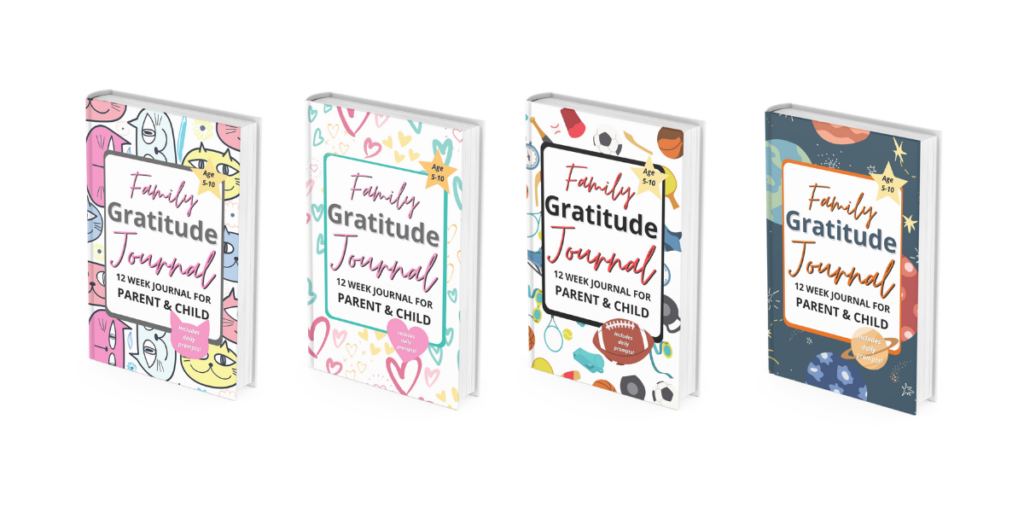
Gratitude Practice for Kids: My 5 Top Tips
Gratitude is not just “positivity”. Actually, it is a scientific fact, proven in psychology research, that gratitude is strongly associated with greater happiness. Implementing a gratitude practice for kids could be one of the most important things you can do.
What are the real benefits of practicing gratitude?
According to a recent Harvard Study, “Gratitude helps people feel more positive emotions, relish good experiences, improve their health, deal with adversity, and build strong relationships.”
If people who practice Gratitude have been shown to have higher levels of happiness and optimism, better sleep, less stress and an improved ability to cope with stress; why wouldn’t you want to start a gratitude practice for kids early in life?
Gratitude is a cornerstone in my life, so consequently, it was important to me to instilled this practice in my children.
Here are my top 5 tips and strategies for making Gratitude part of your family’s daily life.
TIP 1: Do you have a Consistent Gratitude Practice?
Firstly, the most important gift you can give your child, other than your time, is a lesson on how to practice Gratitude. As we know, kids do what we DO and not always what we say. Therefore, if you want grateful children, then you need to step-up and be the role model. Making gratitude a cornerstone of your life will rub off on your kids. And, remember to be mindful of how you talk, what you complain about and how you show your gratitude in everyday activities (vs. just in a daily practice). Also, don’t be afraid to share your gratitude outside of the daily ritual or routine. In my opinion, they will learn best if this is a FAMILY practice.
TIP 2: When should you begin teaching your kids to practice Gratitude?
Answer: NOW!
The younger the better. The first 5-7 years of a child’s life are very formative. Their brains are little sponges and absorb everything.
Kids 0-2:
In the same way our littlest kiddos learn ‘mama’ ‘doggie’ ‘dada’ by hearing/seeing repetition, they can learn gratitude. Make it a practice to tell your babies daily what YOU are grateful for about them and your life. While they may not understand the words, but they will understand the emotion and love.
Kids 2-5:
This is where the practice begins to really form. My suggestion is gratitude part of your bedtime routine. For example, when Sofia was two-years old, we began our practice at night while we snuggled together before she went to sleep. Firstly, I would ask her 3 Things she was grateful for, and then I’d tell her my 3 things as well, as well as WHY I was grateful (so she could begin to learn what gratitude meant).
Watch this video for details on how we taught Sofia Gratitude and hear an actual recording from one of our earliest Gratitude practices!
Kids 5-12:
In this age range, your child will understand the concept of Gratitude. As we get closer to the “preteen” years, it is especially important to prioritize connection and maintain a deep, soulful relationship with our kids. Therefore, making Gratitude a joint-family practice is a great way to bond and learn about each other.
During 2020, my daughter Sofia and I began to use a gratitude journal to record our evening practice. But, we found that the journal we purchased asked the same questions daily and got boring.
Also, Sofia really enjoyed hearing my gratitude practice as well, and the journal we bought had no place for me to write. So, we had an inspired idea to create a special gratitude journal for a parent and child to do together each night before bed. It only takes 3-5 minutes, guides you through questions and will also be a keepsake that you can look back on.
12 WEEK FAMILY GRATITUDE JOURNAL by Sofia & Kimberly Murgatroyd, now available on Amazon!

Kids 12-18:
Obviously, as kids start to get older, they get busy and bedtime routines are typically on their own. So, having a family gratitude practice can get harder. At that point, they may even have their own Gratitude journal or practice. But, I think it’s still important to share as a family. So, you may opt to start a new family ritual to connect. Maybe it’s an after dinner walk, a family game night or even a nightly hot chocolate and chat time. When our older daughter was a teenager, we chose to do our gratitude practice verbally at family dinner, as it was the one place we knew we’d all be together. My suggestion, get creative and make it something THEY want to do. Moreover, get your kids involved in the discussion and ask them to help design a ritual that they’d be excited about joining.
TIP 3: Be Consistent with Your Family Gratitude Practice
Make it a part of your DAILY Routine. When kids are little, it’s easy to add a Gratitude practice or journal to their bedtime routine. It’s a great way to wind down, connect and go to sleep with a full and happy heart.
TIP 4: Don’t Over-complicate Your Gratitude Practice
You can Pinterest 4,000 great ideas of how to practice gratitude. Aps, journals, jars, posters… the list is endless. The best ideas are the easiest and the one you and your kids will ENJOY! Over-complicating this ritual will lead to avoidance of doing it. The KISS principle applies. Keep It Simple Silly-goose 😉
TIP 5: Recognize Your Child’s Attitude of Gratitude
Often as parents, we have a habit of catching our kids being “ungrateful”, but rarely focus on recognizing them when they do something right. Anytime you see/hear your child offer gratitude, acknowledge and celebrate it. The more you praise the practice, they more they feel comfortable sharing their gratitude.
Here’s an example. Last night, I was walking back to my hotel with Sofia, who has a cold and stuffy nose. As we walked, she said “Mommy, I really appreciate how much you take care of me.” I stopped, hugged her and told her how much I love her and appreciated her sharing that with me. To which she replied “Did I just make you cry?”. There may have been a little sweet tear rolling down my face. Unquestionably, was a beautiful moment, made possible because she has a safe place to share her gratitude and she KNOWS it’ll always be received.
CONCLUSION
In this ever changing world, it’s our job as parents to equip our children the tools they need to cope with stress, overwhelm and all that life will throw their way. At the very least, by practicing Gratitude, they are learning an appreciation of people and things in our lives, which will enhance their overall outlook. However, it’s more likely that it’ll shift their perspective of life and lead to a more balanced, less anxious and happier overall existence.


